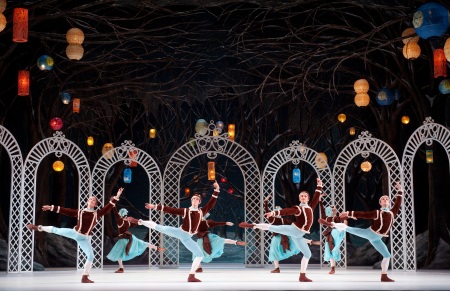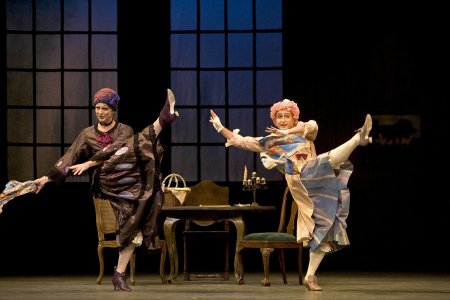The Royal Ballet are delivering wonderful fare this Christmas and New Year, not just with Cinderella, but in two double bills containing Frederick Ashton’s Tales of Beatrix Potter. The first combines it with Matthew Hart’s Peter and the Wolf, and the second with Ashton’s Les Patineurs.
In 1971 Ashton choreographed Tales of Beatrix Potter for film, bringing to life a menagerie of well-loved characters from Potter’s glorious children’s stories, and in 1992 Anthony Dowell put it all on stage. It’s delightful stuff, bringing to life characters such as Mrs Tiggy-Winkle, Jemima Puddle-Duck and the sly Fox, Jeremy Fisher, Squirrel Nutkin, and heaps more, not to mention the mice. The town mice, the little country mice, and those Two Bad Mice who tear up the dolls’ house. It’s wonderful fun, and the music put together by John Lanchbery is absolutely delightful.
Somehow the choreography allows the dancers to bestow convincing personalities on the animals, despite the fact that they perform wearing the huge heads of Rostislav Doboujinsky’s spectacular masks. These brilliantly portray the essence of the Beatrix Potter’s remarkable drawings — she was a hugely talented artist — and the designs by Christine Edzard take us into the various worlds the animals inhabit. This ballet is a treat, and a perfect complement to either Peter and the Wolf, or Les Patineurs.
Peter and the Wolf — a well-known composition by Prokofiev for orchestra and narrator — was turned it into ballet by Matthew Hart in 1995, and is now being revived. Prokofiev’s words and music are brilliantly brought to life by Hart’s choreography and Ian Spurling’s colourful designs. This is much more fun than simply listening to the music and narration, and what a marvellous introduction to choreography and music it is for any child. Will Kemp is superb as the narrator and grandfather — he has enormous presence, and his voice and movements are riveting. Sergei Polunin gives a strong portrayal of the Wolf, and the other solo parts — Peter, the Duck, the Bird, and the Cat — are beautifully performed by Students of the Royal Ballet School.
Les Patineurs is a perennial Ashton delight that has hardly been out of the Royal Ballet’s repertory since its first performance in February 1937. Its flowing choreography and buoyant mood is supported by lovely music from Meyerbeer’s operas, arranged by Constant Lambert. William Chappell’s designs give just the right touch of colour, and the Boy in Blue was beautifully danced by Paul Kay.
As I attended a dress rehearsal, and the casts for Patineurs and Beatrix Potter will change, I’ll make little comment on individual performances, but I loved Yuhui Choe’s dancing and musicality in Patineurs, and in Beatrix Potter I was very taken with the portrayals of Pigling Bland by Jonathan Howells, and Jeremy Fisher by Ryoichi Hirano, though of course all the performers are rendered virtually anonymous by the masks.
Paul Murphy conducted and will continue the run for both programmes. The double bill with Peter and the Wolf continues until December 18th — click here for details; the other double bill runs from December 20th to January 10th — click here for details.






